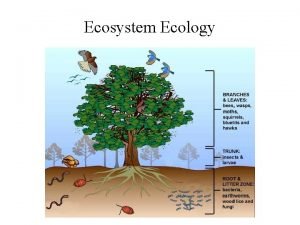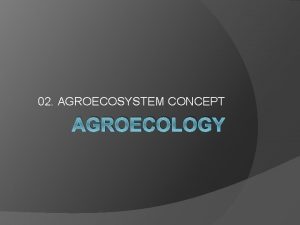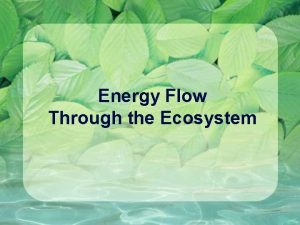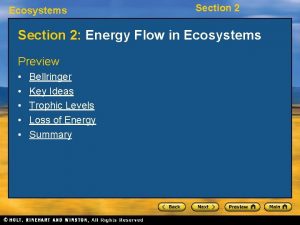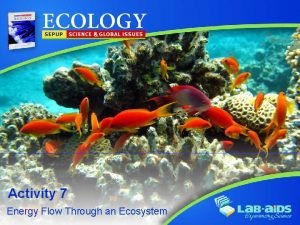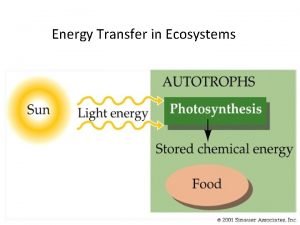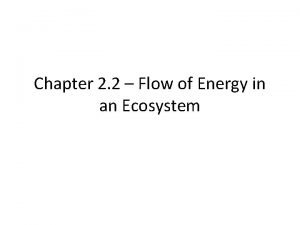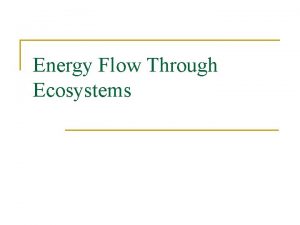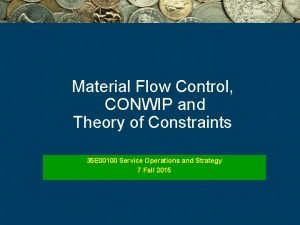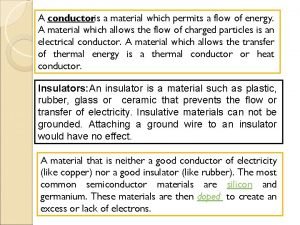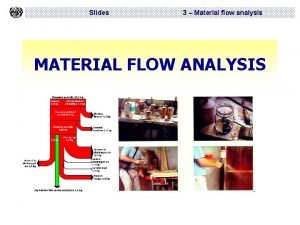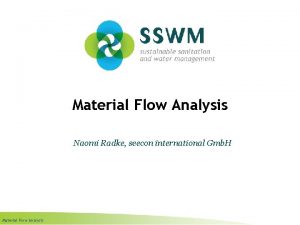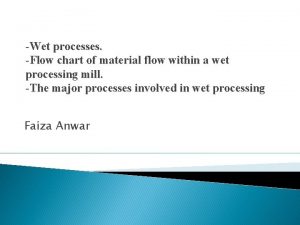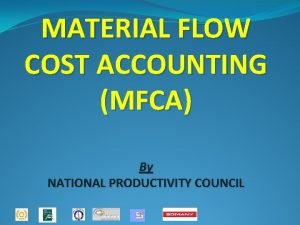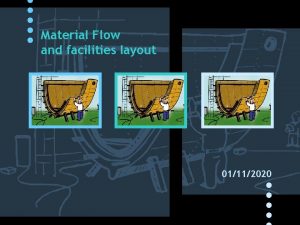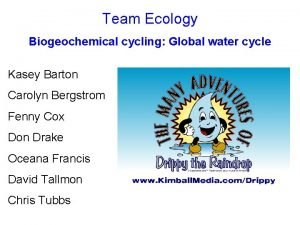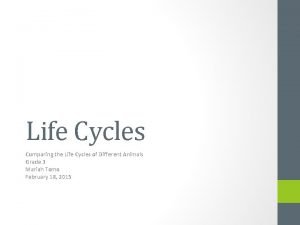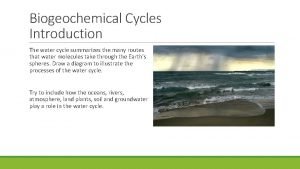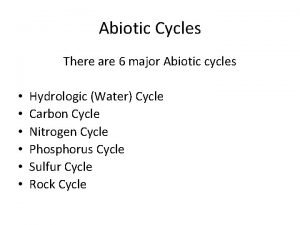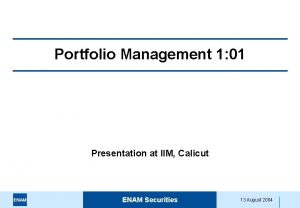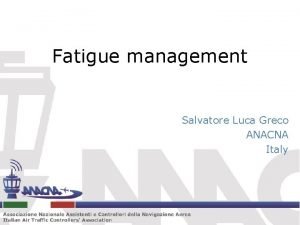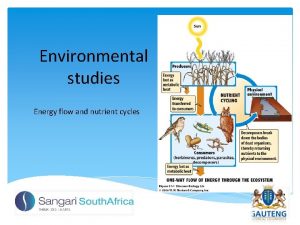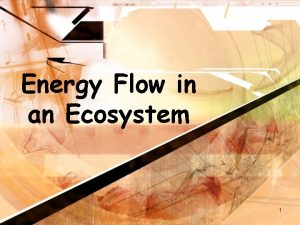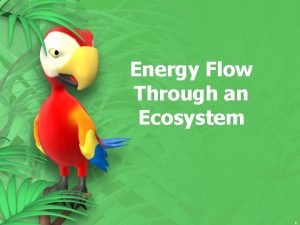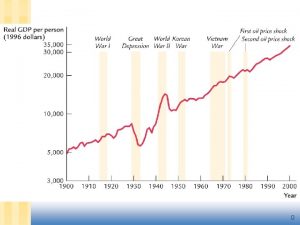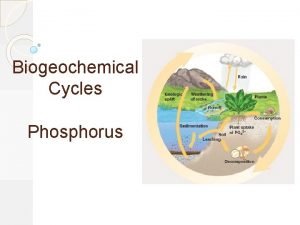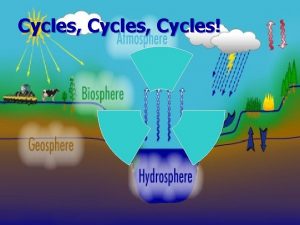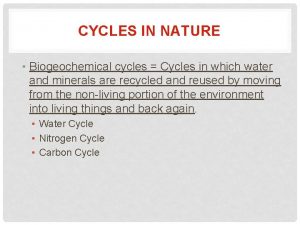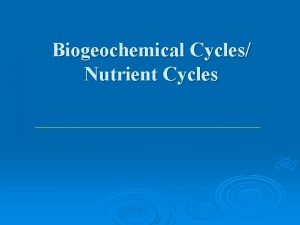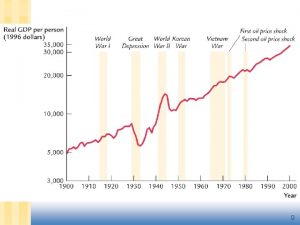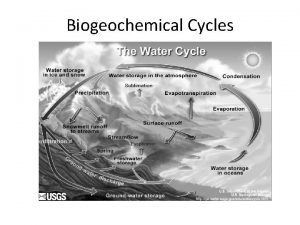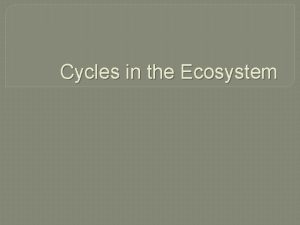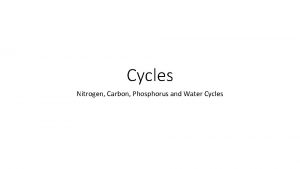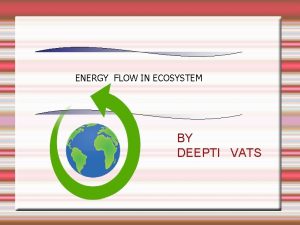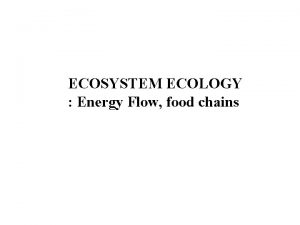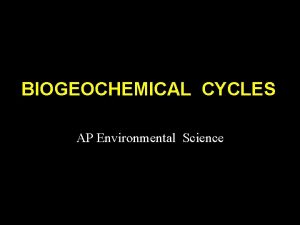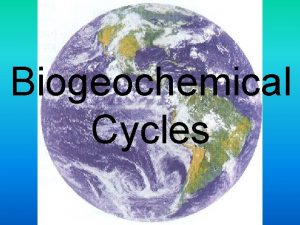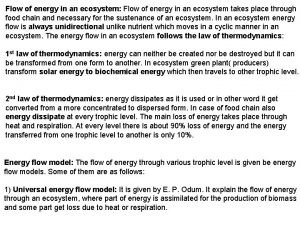ECOSYSTEM STUDIES Energy Flow Ecosystem Material Cycles Test





















































- Slides: 53

ECOSYSTEM STUDIES Energy Flow Ecosystem Material Cycles Test Review

ECOSYSTEM STUDIES Measure the flow (movement, flux) of Energy and Materials in an area (community) Trophic: about or relating to nourishment

ENERGY VS MATERIALS Energy source of life on earth is external to the earth Materials necessary for life are limited to what is on the earth amount of energy utilized by life is a small fraction of the available energy must be recycled through various forms of the living and nonliving world

BASIC ENERGY FLOW Flow from one compartment to another Producers (Autotrophs) Consumers (Heterotroph

BASIC ENERGY FLOW

SUM OF ENERGY AND MATERIAL When studying energy flow, expect that Input = output because

SUM OF ENERGY AND MATERIAL Matter is also conserved. In biological compartments: input of material = amount stored by compartment + output into other systems/ compartments

ENERGY FLOW DIAGRAM

MEASURING ENERGY E=mc 2 units are g x m 2/sec 2 1 Joule = 1 kgxm 2/sec 2 1 calorie = heat necessary to raise 1 g of water 1 degree 1 calorie = 0. 239 Joule 1000 calories = 1 kcal = 1 Calorie

PRODUCTION: BIOMASS Biomass total weight of living organisms Phytomass total weight of plant biomass

PRODUCTIVITY: GPP Amount of energy captured by photosynthesis plant includes that which is respired by the

PRODUCTIVITY: NPP Amount of energy by the plant that remains in the plant (available to consumers) commonly measured in grams (dry weight) /m^2/year

PRODUCTIVITY: NPP varies widely

PRODUCTIVITY: NPP For terrestrial ecosystems, limiting factor is usually water

PRODUCTIVITY: NPP

PRODUCTIVITY BY BIOME Though productivity/m 2 of ocean is low open ocean is so much more abundant than other communities that it is a big contributor to total’s earth Tropical forests and wetlands have the highest productivity /m 2 of terrestrial communities

PRODUCTIVITY BY BIOME Though productivity/m 2 of ocean is low open ocean is so much more abundant than other communities that it is a big contributor to total’s earth Tropical forests and wetlands have the highest productivity /m 2 of terrestrial communities

CONSUMERS Consumers are heterotrophs dependent on reduced carbon compounds produced by autotrophs Three basic levels Herbivores plants Carnivores animals Decomposers f organisms that eat organisms that utilize non organisms that eat -living reduced carbon compounds

CONSUMERS’ ENERGY USE Efficiency of use into growth and reproduction varies greatly among species Output categories: Growth and Reproduction Excretion Respiration (used to generate motion) f

MAMMAL ENERGY USE Roughly: f

CARNIVORES Can be divided into Primary carnivores animals that eat herbivores Secondary carnivores animals that eat primary carnivores Tertiary carnivores f animals that primarily get energy from secondary carnivores

OMNIVORES An animal that gains significant energy from more than one trophic level Many carnivores depend on plant products, especially fruit, for energy f

PYRAMID OF PRODUCTIVITYTERRESTRIAL

PYRAMID OF BIOMASS TERRESTRIAL

COMPARING PYRAMIDS Why aren’t the pyramids the same?

BIOMASS ‘PYRAMIDS’ If producers grow rapidly, may be possible for there to be more biomass of consumers than producers Oligotrophic aquatic systems frequently have a greater mass of zooplankton than of phytoplankton Terrestrial systems almost always have a mass pyramid close to energy pyramids

BIOMASS ‘PYRAMIDS’ Aquatic system with rapidly growing autotrophs Biomass shown by wid

BIOMASS ‘PYRAMIDS’ Terrestrial System Biomass shown by wid

FOOD CHAINS VS FOOD WEBS

ECOSYSTEM MATERIAL CYCLES

MATERIAL CYCLES Ultimately materials (elements) must cycle among compartments in which it is found Biogeochemical cycle – the global paths that an element takes

REMINDER ‘Ecosystem’ not only includes biotic, but also abiotic factors. Abiotic factors include: atmosphere and its molecules water and molecules dissolved in it

MATERIALS CYCLE, ENERGY FLOWS Energy moves from a source Elements (material) are not gained or lost, the constant total amount does move around compartments holding different forms Cycle – movement of an element among its compartments

INGESTION AND EXCRETION In an organism, not all food that is eaten is absorbed – some is excreted Not all compounds that are absorbed are metabolized equally efficiently Compounds/elements that are absorbed, but not metabolized, accumulate in the both Amount an individual has is called the

HEAVY METALS Some metals (Fe, Cu, Zn) are essential micronutrients for most organisms Lead (Pb) and mercury (Hg) have a variety of negative effects on organisms Excreted very slowly (half life over 1 year) so they tend to accumulate in the body

BIOMAGNIFICATION Toxicity of compounds increases with increased concentration Concentration increases at each trophic level

BIOMAGNIFICATION

BIOGEOCHEMICAL CYCLING Bio – biosphere, living organisms Geo – stands for geological compartments (earth’s crust, ocean, atmosphere) Chemistry –involved because the elements are transformed among a variety of compounds

MATERIAL CYCLES Compartments are also called reservoirs Movement into a compartment is input Movement out of a compartment is called output Amount in the compartment called pool size If the rate of flow out of the pool is low, the pool size is likely to be large

TURNOVER (RESIDENCE TIME) Length of time in the pool Compounds that can be made by biological systems are usually broken down by biological systems Why? otherwise those compounds would build up indefinitely

TURNOVER (RESIDENCE TIME) Simple sugars are rapidly metabolized and turnover quickly Complex sugars take longer to turnover in the body (‘pool’)

BIOSPHERE RECYCLING Dead animals and plants are called detritus They are recycled by organisms called decomposers Some parts have longer residence times than others Microorganisms are a necessary part of recycling

LOCAL CYCLING OF MATERIAL Rain leaches nutrients from the soil into groundwater Plant roots capture some leaching nutrients and transport them upward to the leaves When the leaves die and fall to the ground the nutrients again enter the soil

LOCAL CYCLING OF MATERIAL

LOSSES AND GAINS OF NUTRIENTS Local systems can lose/gain substantial amounts of various nutrients Changes in local amount of nutrients can dramatically impact the local system For example: Eutrophication of lakes

GLOBAL CARBON CYCLE Carbon dioxide in atmosphere 370 ppm = parts per million Carbon dioxide dissolved in ocean is 50 times the amount in atmosphere Geological forms of carbon: Oil, Coal, Graphite, Diamonds

GLOBAL CARBON CYCLE

GLOBAL NITROGEN CYCLE While the concentration of CO 2 has increased since 1800, the % increase of N is much greater Amount of nitrogen added by humans is almost = that of natural sources N 2 is the most common gas of our atmosphere, but it is very unreactive

TEST REVIEW

TEST #1 INFORMATION Next class: Oct 13 Format: 25 Multiple Choice questions 2 Short Answer questions (5 marks each) Worth 20% of your final mark

TEST #1 INFORMATION Please bring: Pens (pencil cannot be remarked) Student Card 1 ½ hour test

TEST #1 INFORMATION Fair game: Lecture 1 – 4 Labs 1 and 2 Guest Lecture Textbook Chapters

GUEST LECTURER Sean Boyle, Ph. D. Candidate
 Energy flow and material cycling in ecosystem
Energy flow and material cycling in ecosystem Energy flow and material cycling in ecosystem
Energy flow and material cycling in ecosystem How does energy flow in a food web
How does energy flow in a food web Section 2 flow of energy in an ecosystem
Section 2 flow of energy in an ecosystem Energy flow in ecosystem
Energy flow in ecosystem Describe the flow of energy in the kelp forest ecosystem
Describe the flow of energy in the kelp forest ecosystem Energy transfer in ecosystem
Energy transfer in ecosystem Principles of ecology 2 flow of energy in an ecosystem
Principles of ecology 2 flow of energy in an ecosystem Regents biology food chains and energy in ecosystems
Regents biology food chains and energy in ecosystems Energy roles in an ecosystem
Energy roles in an ecosystem How does energy flow through an ecosystem
How does energy flow through an ecosystem Ecological succession
Ecological succession Flow of energy vs flow of matter
Flow of energy vs flow of matter Paradigm shift from women studies to gender studies
Paradigm shift from women studies to gender studies Energy energy transfer and general energy analysis
Energy energy transfer and general energy analysis Energy energy transfer and general energy analysis
Energy energy transfer and general energy analysis Cash flow forecast table
Cash flow forecast table Feature of size
Feature of size Usage variance formula
Usage variance formula Popular culture examples
Popular culture examples The knowledge language values customs and material objects
The knowledge language values customs and material objects Material and non material culture examples
Material and non material culture examples Meaning of useful and harmful materials
Meaning of useful and harmful materials Material flow analysis ppt
Material flow analysis ppt Material flow control
Material flow control Material flow icon
Material flow icon The material that permits the flow of electricity
The material that permits the flow of electricity Material and information flow analysis
Material and information flow analysis Material and information flow analysis
Material and information flow analysis Naomi radke
Naomi radke Flow chart of wet processing
Flow chart of wet processing Bhel eprocurement
Bhel eprocurement Material flow cost analysis
Material flow cost analysis Material flow layout
Material flow layout A material through which charges cannot flow easily
A material through which charges cannot flow easily Name two categories used to classify properties of matter
Name two categories used to classify properties of matter Mandarin cycles
Mandarin cycles Alliteration of cycle
Alliteration of cycle Importance of water cycle
Importance of water cycle Pdsa cycle nursing
Pdsa cycle nursing Precession milankovitch cycles
Precession milankovitch cycles Bill nye the science guy butterfly life cycle
Bill nye the science guy butterfly life cycle Relationship between transaction cycles
Relationship between transaction cycles Cpi cycles per instruction
Cpi cycles per instruction Biogeochemical cycles water cycle
Biogeochemical cycles water cycle Biogeochemical cycles apes
Biogeochemical cycles apes What is the major abiotic reservoir for phosphorus
What is the major abiotic reservoir for phosphorus What happens to phosphorus that erodes from rock and soil?
What happens to phosphorus that erodes from rock and soil? Cycles in nature
Cycles in nature Joke cycles
Joke cycles Joke cycles
Joke cycles Biogeochemical cycles class 9 ppt
Biogeochemical cycles class 9 ppt Sleep wake cycles
Sleep wake cycles Biogeochemical cycles foldable
Biogeochemical cycles foldable
